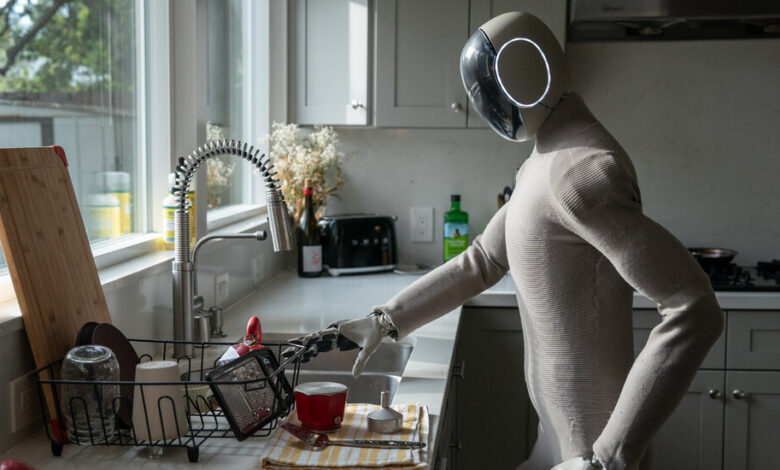Home Humanoid Robot attack

Recently in the morning, I knocked on the front door of a beautiful two -storey house in Redwood City, California. Within seconds, the door was opened by a faceless robot prepared in a beige bodisuit that tightened his trim with waist and long legs.
This Svelte Humanoid appeared to me as a Scandinavian accent, and I offered to join hands. As our palms found, it said: “I have a strong grip.”
When the house owner, a Norwegian engineer named Bernat Bernich asked for some bottled water, the robot turned, went to the kitchen and opened the refrigerator with one hand.
Artificial Intelligence is already driving a car, writing essays and even writing computer code. Now, humanoids, manufactured to look like machines and operated by AI, are ready to go into our homes so that they can help with daily tasks. Mr. B Børnich is the chief executive and the founder of a start-up called 1x. Before the end of the year, his company is expected to put its robots, Neo in more than 100 houses in Silicon Valley and other places.
Their start-ups are among dozens of companies planning to sell humanoids and bring them into both homes and businesses. According to a research firm pitchbook tracking the technical industry, investors have added $ 7.2 billion to more than 50 start-ups since 2015. Humanoid frenzy reached a new peak last year, when the investment was at $ 1.6 billion. And it did not include the Arabs who are pumping in Elon Musk and Tesla, their electric car company, optimus, a humanoid that they started construction in 2021.
Entrepreneurs such as Mr. Bornich and Mr. Musk believe that Humanoids will one day do a lot of physical work, now handled by people, including domestic work such as wipes of counters and domestic work such as wipes of counters, making cars on a assembly line such as package and factory labor like factory labor.
Simple Robot – for example, small robot weapons and autonomous vehicles – have long shared the charge inside warehouses and factories. Now, companies are betting that machines can deal with a wide range of tasks by mimicking methods that people walk, bend, bend, bend, reach, reach, catch and work generally.
Because homes, offices and warehouses are already built for humans, these companies argue, Humanoids are better equipped to navigate the world than any other robot.
Humanoid labor has been pushed over the years, both robotic hardware and AI technologies have fuel from advances that allow robots to rapidly learn new skills. But these humanoids are still a bit of a mrust.
Internet video has broadcast by showing remarkable skill of these machines over the years, but very often, they are directed from distance by humans. And simple tasks like loading dishwashers are anything simple for them.
“There are many videos that give false imprint of these robots,” said Professor Kane Goldberg, a Robotics at the University of California, Berkeley. “Although they look like humans, they are not always behaving like humans.”
Neo said “Hello” with a Scandinavian accent as it was operated by a Norwegian technician in the basement of Shri Borniich’s house. (Finally, the company wants to build a call center, where perhaps dozens of technicians will support robots.)
The robot passed through the dining room and kitchen on its own. But the technician talked to NEO and directed his hands from a distance through a virtual reality headset and two wireless joystics. Robots are still learning to navigate the world on their own. And they need a lot of help in doing it. at least for now.
‘I saw a level of hardware that I did not think was possible.’
I first visited 1x offices in Silicon Valley about a year ago. When a robot named Eve entered the room, by opening the door, I could not feel that this wide -eyed robot was actually a person in the dress.
Eve went to the wheels, not legs. And yet, it still felt human. I thought of “Sleeper”, 1973 Woody Alan filled with science-fi comedy robot butlers.
The engineers of the company had already built Neo, but did not learn to walk. An early version was hanging on the laboratory wall of the company.
In 2022, Mr. Bornich logged into a zoom call with an AI researcher named Eric Jung. They never met.
Mr. Jung, who now 30, worked at a robotics lab at Silicon Valley Headquarters in Google, and 42-year-old Mr. Borniich made a start-up in Norway, called Halodi Robotics.
An investor asked Mr. Jang to collect some information on Halodi, to see if it was worth an investment. Mr. Borniich showed the company’s Humanoids, Eve. This was something he had dreamed of building because she was a teenager, inspired – by many robotists – by science fiction (his personal favorite: 1982 film “Blade Runner”).
The way Mr. Jung went to Eve, it was entered. He compared Zoom call to a scene in the science-fi television drama “Westworld”, in which a man attends a cocktail party and is surprised to know that everyone in the room is a robot.
“I saw a level hardware that I did not think was possible,” Mr. Jung said.
The investor did not invest in Halodi. But Shri Jung soon convinced Mr. Borniich to join the army.
Mr. Jung was part of a Google team, using mathematical systems called neural networks to teach new skills, allowing robots to learn from data that reflect real -world functions. After seeing the Eve, Mr. Jang told Mr. Bornich that he should apply the same technique for humanoids.
The result was a cross-eleventh company that he named 1x. Start-up, which has increased to about 200 employees, now supports more than $ 125 million in funding from investors including Tiger Global and Artificial Intelligence Start-up Openai.
‘This is all learned behavior.’
When I returned to the company’s laboratory about six months after meeting Eve, I was congratulated by a walking Neo. He taught it to walk in the digital world completely. By imitating the physics of the real world in an environment like video-game, they can train a digital version of their robot to stand and balance and eventually, take steps.
After training this digital robot after months, he transferred everything learned to a physical humanoid.
If I stepped in the way of Neo, it would stop and move around me. If I pushed its chest, he stayed on his feet. Sometimes, it did not stumble or knew what to do. But it can rotate in a room like people do.
“All this is learned,” Mr. Jung said, as Neo clicked against the floor with each step. “If we put it in any environment, it should be known how to do it.”
Training a robot to do domestic work, however, is a completely different possibility.
Because the physics of loading dishwasher or folding laundry is highly complex, one cannot teach these tasks in the 1x virtual world. They have to collect data inside real houses.
When I visited Mr. Bornich’s house a month later, Neo started struggling with the refrigerator’s stainless-steel door. The Robot’s Wi-Fi connection was dropped. But once the hidden technician rebooted Wi-Fi, he originally directed the robot through his short work. Neo gave me a bottled water.
I also saw a washing machine loading a washing machine to lift clothes from a laundry basket. And as Mr. Bornich and I chat outside the kitchen, the robot started wiping the counters. All this was done through remote control.
Even when controlled by humans, the neo can leave a cup or struggle to find the right angle because it tries to toss an empty bottle under a sink into a garbage. Although Humanoids have jumped and improved in the last decade, they are not agile like humans. For example, Neo cannot lift its arms above its head.
For uninterrupted, neo may also feel a bit scary, such as something else that does not partially look human and partially. It is especially strange to talk to this, given that you are actually talking to a distance technician. It is like talking to the dummy of a ventrylocvist.
‘What we are selling is more journey than a destination.’
By guiding Neo through home works, Mr. Bornich and their team can collect data – using cameras and other sensors installed on the robot – shows how these tasks are done. 1x engineers can then use this data to expand and improve the skills of NEO.
Just as Chatgpt can learn to write a term paper by analyzing the text made from the internet, a robot can learn to clean the windows by pointing the pattern in the hours of the digital video.
Most human efforts, including Optimus and similar projects of Shri Musk, such as Apptronik and Figure AI, are designing humanoids for warehouses and factories, arguing that this tightly controlled environment will be easier to Navigate for robots. But through selling humanoids in homes, 1x expects to collect huge amounts of data that can eventually show these robots how to handle the chaos of daily life.
First of all, the company will have to find people who will welcome the initial version of a strange new technology in their homes – and will pay for it.
1x has not yet set a price for these machines, which makes it inside its own factory in Norway. The manufacture of a humanoid is more than about more than the manufacture of a small car – thousands of dollars.
To reach its capacity, NEO must capture the video of what happens inside the houses. In some cases, the technicians will see what happens in real time. Fundamentally, it is a robot that learns on the job.
“What we are selling is more journey than a destination,” said Mr. Bornich. “It’s really going to be a bumpy road, but Neo will do things that are really useful.”
‘We want you to give us your data on your terms.’
When I asked Mr. Borniich how the company handles the privacy after the company is inside the houses, they explained that technicians working with remote call centers, will only take control of robots if they receive approval from the owner through the smartphone app.
He also said that data will not be used to train the new system until at least 24 hours after assembled. This will allow 1x to remove any video that customers do not want the company to use.
“We want you to give us your data on your terms,” Mr. Bornich said.
Using this data, Mr. Bornich expects to produce a humanoid that can do almost any domestic work. This means that NEO can potentially change workers who make their living cleaning houses.
But it is still year away – best. And due to the increasing lack of workers that handle both the house cleaning and the care of both the elders and children, the organizations representing these workers welcome the rise of new technologies working in the house – provided companies like 1x create robots that work well with human workers.
AI-Jen Poo, president of the National Domestic Workers Alliance, said, “These equipment can make some more loud, tax and dangerous work easier-and allow workers to focus on things that only human workers can only offer,” AI-Jan Pu, President of the National Domestic Workers Alliances, who represent the country’s house cleaner, home-kerrs and neanis.
Soon, Neo started cleaning huge windows on the edge of the house. Then, as I turned to Mr. Bornich, I heard an accident on the kitchen floor. After an electrical failure, the Neo fell on the backward – fainted away.
Mr. Borniich picked up the robot, as it was a small teenager, took it to the living room and placed it on a chair. Even when the Neo came out, it looked human.
Other humanoids found by me may be intimidating. Neo is not less than five and less than half feet and 66 pounds. But I was still surprised whether it could injure a pet – or a child – such as a fall.
Will people let this machine go to their homes? How soon will its skills improve? Can it free people from their daily tasks? These questions cannot be answered yet. But Mr. Borniich is pressing further.
“There are many people like me,” he said. “He has dreamed of something like this happening in his house because he was a child.”
,
#Home #Humanoid #Robot #attack




